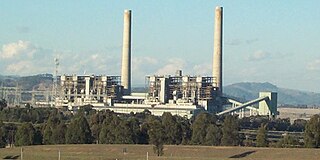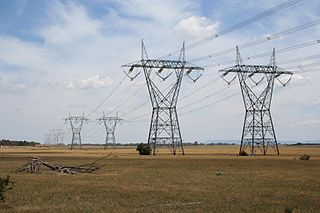
Solar Energy Generating Systems (SEGS) is a concentrated solar power plant in California, United States. With the combined capacity from three separate locations at 354 megawatt (MW), it was for thirty years the world's largest solar thermal energy generating facility, until the commissioning of the even larger Ivanpah facility in 2014. It was also for thirty years the world's largest solar generating facility of any type of technology, until the commissioning of the photovoltaic Topaz Solar Farm in 2014. It consisted of nine solar power plants in California's Mojave Desert, where insolation is among the best available in the United States.

The Moss Landing Power Plant is a natural gas powered electricity generation plant located in Moss Landing, California, United States, at the midpoint of Monterey Bay. Its large stacks are landmarks, visible throughout the Monterey Bay Area. The plant is owned and operated by Houston-based Dynegy and currently has a generation capacity of 1020 MW (net) from its two combined cycle generation units. It was once the largest power plant in the state of California, with a generation capacity of 2560 MW, before its two large supercritical steam units were retired in 2016.

Eraring Power Station is a coal-fired power station consisting of four 720 MW Toshiba steam-driven turbo-alternators for a combined capacity of 2,880 MW. The station is located near the township of Dora Creek, on the western shore of Lake Macquarie, New South Wales, Australia and is owned and operated by Origin Energy. It is Australia's largest power station. The plant has two smokestacks rising 200 m (656 ft) in height. It was scheduled for closure by mid-2025, after a failed attempt to sell the loss making power station back to the state government. The New South Wales Government in May 2024 extended the operational life of Eraring to August 2027.

Munmorah Power Station is a demolished coal-fired power station with four 350 MW English Electric steam driven turbo-alternators for a combined capacity of 1,400 MW. The station was located near Doyalson, on the shores of Lake Munmorah, New South Wales, Australia and was owned and operated by Delta Electricity, a company owned by the New South Wales Government.

Liddell Power Station is a decommissioned coal-fired thermal power station that had four 500 megawatts (670,000 hp) EE steam-driven turbine alternators, providing a combined electrical capacity of 2,000 megawatts (2,700,000 hp).

The Kogan Creek Power Station is a 750 megawatt coal fired power station owned by CS Energy on the Darling Downs in Queensland. The $1.2 billion plant is situated at Brigalow, in the Surat Basin between Dalby and Chinchilla.

Energy in Victoria, Australia is generated using a number of fuels or technologies, including coal, natural gas and renewable energy sources. Brown coal, historically, was the main primary energy source for the generation of electricity in the state, accounting for about 85% of electricity generation in 2008. The amount of coal-fired power has decreased significantly with the closure in 2017 of the Hazelwood Power Station which supplied around 20% of Victoria's electricity, and to a lesser extent with the exit of Anglesea Power Station in 2015. Brown coal is one of the largest contributors to Australia's total domestic greenhouse gas emissions and a source of controversy for the country. Australia is one of the highest polluters of greenhouse gas per capita in the world.

The Tilbury power stations were two thermal power stations on the north bank of the River Thames at Tilbury in Essex. The 360 MW dual coal- and oil-fired Tilbury A Power Station operated from 1956 until 1981 when it was mothballed, prior to demolition in 1999. The 1,428 MW Tilbury B Power Station operated between 1968 and 2013 and was fueled by coal, as well as co-firing with oil and, from 2011, biomass. Tilbury B was demolished in 2016–19. Since 2013 three other power stations have been proposed or constructed in Tilbury.

The energy sector in Hawaii has rapidly adopted solar power due to the high costs of electricity, and good solar resources, and has one of the highest per capita rates of solar power in the United States. Hawaii's imported energy costs, mostly for imported petroleum and coal, are three to four times higher than the mainland, so Hawaii has motivation to become one of the highest users of solar energy. Hawaii was the first state in the United States to reach grid parity for photovoltaics. Its tropical location provides abundant ambient energy.

The Whyalla Steelworks is a fully integrated steelworks and the only manufacturer of rail in Australia. Iron ore is mined in the Middleback Range to feed the steelworks, resulting in the distribution of finished steel products of over 90 different grades. It occupies a 1,000 ha site on the shore of False Bay, Spencer Gulf and is the largest employer in Whyalla, South Australia.

The Solnova Solar Power Station is a large CSP power station made up of five separate units of 50 MW each. The facility is part of the Solucar Complex, in Sanlúcar la Mayor, in Spain, the same area where the PS20 solar power tower is also located. With the commissioning of the third 50 MW unit, the Solnova-IV in August 2010, the power station ranks as one of the largest CSP power stations in the world.

The Mount Newman railway, owned and operated by BHP, is a private rail network in the Pilbara region of Western Australia built to carry iron ore. It is one of two railway lines BHP operates in the Pilbara, the other being the Goldsworthy railway.
The Christmas Creek mine is an iron ore mine located in the Pilbara region of Western Australia, 61 km south-south-west of Nullagine, in the Chichester Range.
Canadian Solar Inc. is a global renewable energy company. Headquartered in Guelph, Ontario, the company manufactures solar PV modules, provides battery energy storage solutions and develops utility-scale solar power and battery energy storage projects.

Newman Power Station is a power station in Newman, Western Australia, located about 1,186 kilometres (737 mi) north of Perth, and 9 kilometres (5.6 mi) north of the Tropic of Capricorn. It is a 178-megawatt (239,000 hp) natural-gas-fired power station servicing BHP's isolated grid. Newman currently provides 100% of the power requirement of the islanded grid which supplies electricity to the Area C mine operated by BHP.
Solar power in Chile is an increasingly important source of energy. Total installed photovoltaic (PV) capacity in Chile reached 8.36 GW in 2023. Solar energy provided 19.9% of national electricity generation in Chile in 2023, compared to less than 0.1% in 2013.

The main power supply for Shetland is provided by Lerwick Power Station, located in Gremista, 2 kilometres (1.2 mi) northwest of Lerwick town centre. This is the principal source of electrical energy for Shetland, however currently about 20 MWe is provided by the Sullom Voe Terminal power station which comprises 4 x 23 MWe Gas Turbines, the future of which is uncertain. Opened on 27 May 1953 the station is diesel-fuelled and generates a total of 66 MW of power.
Neoen is a French producer of exclusively renewable energy headquartered in Paris, France. Founded in 2008, it develops, finances, builds and operates solar power plants, onshore wind farms and energy storage solutions. As at 31 December 2023, the company's total capacity was 8 GW, made up of 50% solar, 30% wind and 20% battery storage. Neoen aims to attain 10 GW in operation or under construction by 2025.

East Rockingham Waste to Energy is a waste-to-energy power station under construction located in East Rockingham, Western Australia. Once completed, the facility is scheduled to process in excess of 300,000 tonnes of waste and will produce 29 MW of power.
The Balama Solar Power Station, is a 11.25 megawatts (15,090 hp) solar power plant under construction in Mozambique. The project is owned and under development by Solarcentury an independent power producer (IPP), based in the United Kingdom. The solar farm will be connected to an 8.5 MW/8.5MWh battery storage system. The two energy sources will then be synchronized with the existing 15.4 MW diesel-fired thermal power source, to form a 35.15 MW hybrid power station. The energy generated here is used in the Balama Graphite Mine, owned and operated by Syrah Resources, a Canadian minerals and technology company.
















